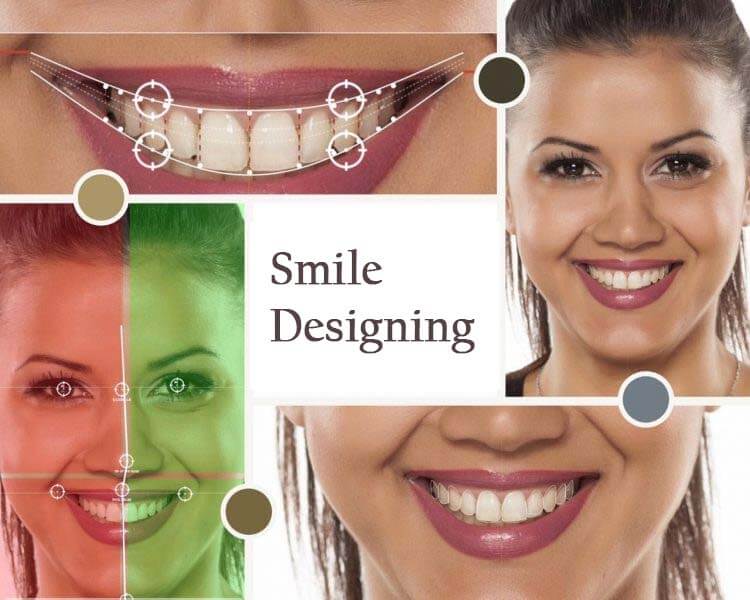
What are the steps involved in Digital Smile Design?
The DSD process has four significant steps 1) DESIGN, 2) PLAN, 3) PRESENT and 4) PERFORM.
STEP ONE: ANALYSE THE FACE AND DESIGN THE SMILE BETTER
As smile designers and smile restorers, we design smiles better, if the design is facially driven. The facial analysis considers your features like facial symmetry, right or left facial dominance, reference planes of the eyes, the mouth and the teeth, the curvature of the lips, lip dynamics, the number of teeth and gum display in a full smile and the chin prominence.
By taking these facial traits into account and analyzing them, we can personalize the “smile” that best suits you. With the use of readily available digital technologies like digital photographs and 3D scans of the face and the mouth, 3D x rays of the jaws and artificial intelligence, we create a “virtual you” in the process of designing a smile.
Just as good buildings are explicitly designed for context, climate and culture… the smile is designed specifically for your appearance and personality.
STEP TWO: BETTER DIAGNOSIS AND TREATMENT PLANNING
Once the face analysis and initial smile design are complete, the initial plan is shared with the interdisciplinary planning team, which comprises of the principal smile designer, the restorative dentist, the orthodontist, the gum specialist and the dental technician. The international background team at Spain for DSD and Costa Rica for Invisalign also receives the data to allow technical support. This planning team and background team with better information to begin with face analysis and smile design brainstorm on the initial plan to improvise the treatment plan.
The process is just like how an architect would analyse your requirements and prepare the designs and drawings for your dream home with inputs from engineers for the contractor to execute.
STEP THREE: IMPROVE THE PRESENTATION OF THE TREATMENT PLAN
Now that we have a better design and treatment plan, it’s time to unveil your treatment plan.
Just like you would never buy a car without a test drive, how about doing the same with your new smile? You get to see the new smile, feel the new smile, experience the new smile first hand, through a prototype by people.
Presentation is perhaps the most critical step between design and execution. An architect would create 3D views, walk-throughs and mood boards to translate your imagination into reality.
STEP FOUR: PERFORM BETTER DENTISTRY USING TECHNOLOGY
The advent of 3D technology has opened up a whole new range of dentistry possibilities and in many other fields. With 3D technology being incorporated right at the beginning of the project with the scans of the face, teeth and jaws, it sets the ball rolling into the diagnosis and planning phase. The 3D trial of the smile prototype ensures that you have all the information and fully understand the process. Now is the time to turn these ideas into reality with “Guided Dentistry” and “Digital Quality Control.”
3D technology allows the team to respect the design plan of the smile with a plethora of guides for the different procedures, within the framework of guided dentistry like the DSD click guides for “all on 4” dental implants, Perio-guides for adjusting the gum and the bone levels in the smile, direct guides for direct composite natural restorations and the orthognathic splints for jaw correction surgery.
The beauty of using technology goes further than that. Once the guided procedures are fully executed, 3D technology enables digital quality control to access any deviation from the plan. It is an excellent tool to introduce improvisation at work and also standardization.
Is Cosmetic Dentistry & Digital Smile Design the same?
In our opinion, cosmetic dentistry has a very superficial meaning and relevance, as its primary purpose is limited to an improvement in appearance or aesthetics. This does not necessarily involve facial analysis or functional improvement. Any limited appearance-enhancement without functional gains is incomplete per se.
On the other hand, although smile design brings a drastic improvement in appearance, it is fully based on the face and personality study to create a smile that suits you best. It improves function and improves durability at the same time. The digital shift in smile design also brings the added benefits of digital design and planning, predictability, reproducibility and also post-work assessment.
In architectural relevance, cosmetic dentistry would look more like exterior paint or a cladding job that would improve the facade without structural improvements to enhance usability and durability.
“DESIGN is not just what it looks like and feels like. DESIGN IS HOW IT WORKS.” – Steve Jobs
